 Using Signals
Using Signals
Summary
I hope that this tutorial has illustrated the need for car whenever we make a signal whilst driving. We use signals as part of the MSM routine but remember when you are mentally going through the routine you should be saying
Mirrors - (Consider a) Signal - Manoeuvre
We should always be considering other road users and the effect that our signals can have them - it takes thought, skill and practice to become proficient in the use of signals so that using them does not create the confusion that they are designed to avoid.
If you're taking driving lessons with me we'll be practising all the signals that have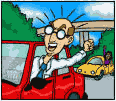
 been discussed in this driving tutorial but we'll also be looking and learning about how to indicate our intentions by the positioning and attitude of our vehicle (I can imagine you now thinking "a vehicle with attitude" - well these cars and drivers are both giving very positive signals and they're not good ones! Getting involved in these types of scenarios means only one thing: you're not concentrating on driving - disaster may be only moments away.
been discussed in this driving tutorial but we'll also be looking and learning about how to indicate our intentions by the positioning and attitude of our vehicle (I can imagine you now thinking "a vehicle with attitude" - well these cars and drivers are both giving very positive signals and they're not good ones! Getting involved in these types of scenarios means only one thing: you're not concentrating on driving - disaster may be only moments away.
You'll often see drivers traveling much too fast for the conditions and poorly positioned on the road - their intention is often clear - "out of my way, I'm coming through"; let them, it's not worth the aggravation of arguing with them.
So I'll be encouraging you to maintain a courteous and thoughtful attitude towards other road users, but this doesn't mean waving at them to say "thank you" as I often see - you hands need to stay on the wheel at all times when we're driving: try a smile instead. Try smiling at a busy junction when you catch the eye of other drivers and see how often they will allow you to proceed - it works wonders.
often see - you hands need to stay on the wheel at all times when we're driving: try a smile instead. Try smiling at a busy junction when you catch the eye of other drivers and see how often they will allow you to proceed - it works wonders.
Here is another example.
The driver of the maroon car has to overtake the stationary red car. There is no closely following traffic or other road users in the area - is a signal really necessary?
[Summary]
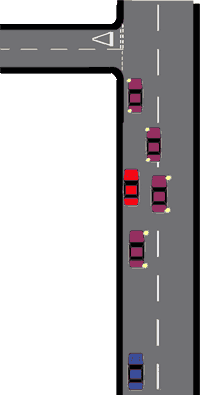
Drivers often give signals when there is no one about who would benefit from them. This is not good practice as a thoughtless signal can cause the very confusion that it is designed to eliminate.
A signal is not always necessary before moving off or stopping.
You should always check to see whether a signal would be of benefit to any other road users.
[Next]
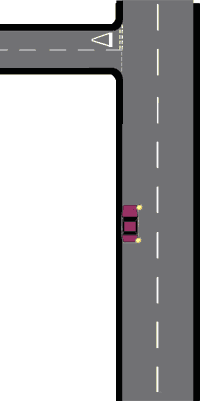
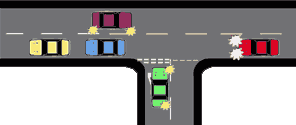
Can you remember earlier in the tutorial when I spoke about flashing headlights - look at this signal!
The driver of the red car has stopped short of the junction so others can have access to it whilst the traffic ahead is stationary.
He has flashed his headlights - but who is the signal meant for?
What would happen if the drivers of the maroon and green cars both decided to proceed with their manoeuvres on seeing the flashing lights.
[Next]
You must always consider how other road users will interpret your signals - look at this signal.
The driver of the maroon car is intending to turn left at the junction and signals early without considering the following vehicle.
The driver of the blue car could well be expecting him to slow down in preparation for stopping at the side of the road.
Imagine what could happen if the driver of the blue car pulled out to overtake!
[Next]
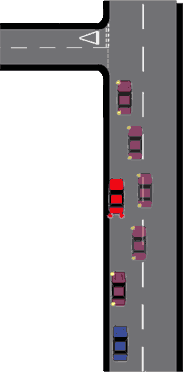
And this driver has cancelled his signal before the manoeuvre has been completed.
Is he going to turn at the junction? - or has he changed his mind?
[Next]
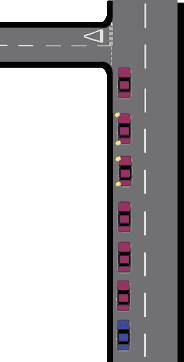
Can both be confusing to others. This drivers' signal has been showing for too long.
The following driver could easily believe that the signal has been accidentally left on following a previous manoeuvre.
[Next]
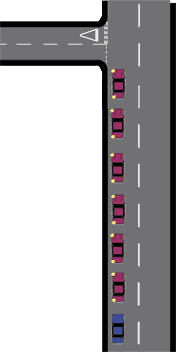
Here the driver of the red car has delayed his signal until he is well past the point of turn into the first junction.
But he is still making his signal in good time for the following vehicle to be able to adjust his planning and consider what he might have to do.
The driver of the green car will have had no doubt of the the intentions of the driver of the red car.
[Next]
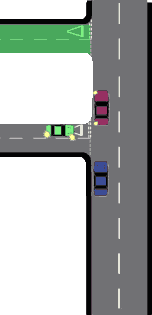
Here we see the real intention of the driver of the red car - apart from creating confusion he could have caused the situation to become dangerous if the driver of the green car had decided to trust his signal.
Always make absolutely sure that you fully understand another drivers' intentions - in this situation a good driver would wait until the red car had begun to make the turn and the blue car had cleared the area.
Let's see when the signal should have been given.
[Next]
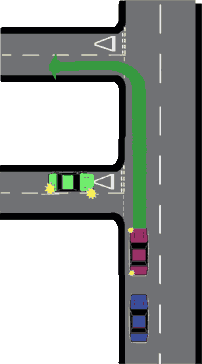
Some situations call for special care in the timing of your signals.
Here the driver of the red car appears to be turning left - the blue car has not moved out to pass him.
The driver of the green car emerging onto the main road may think it safe to begin his manoeuvre.
But what is the real meaning of the red car drivers' signal?
[Next]
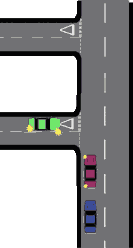

Here the leading vehicle has waited too long before signaling.
The driver of the blue car will not have enough time to adjust his planning and may have to brake harshly when the leading vehicle slows to make the turn.
[Next]

For any signal to be effective it must be given in good time so that other road users have time to see it and act on it.
But we must always be careful not to make the signal too early or too late.
This driver is signaling. too early - the driver of the blue car may well be expecting him to pull over and stop at the side of the road.
[Next]
Using Signals
When you learnt the basic of the MSM routine I hope you were taught Mirrors - (Consider a Signal). Using a signal should not be an automatic reaction - too often drivers apply a signal (or don't apply a signal) with no real thought as to the effect it could have on other road users. Use the links below to see some of the considerations you should be making when deciding if, where and when to signal.
Timing
Delaying.
Signaling. for too long/short a time
Confusing
Unnecessary and misleading signals
[Back][Next]
Arm - arm signals are not often used by drivers but can also be used to indicate your intention to change direction either in place of the indicators if they had failed or to re-enforce your intention. One of the most useful arm signals to use is the signal to slow down which can be very useful when approaching pedestrian crossings to indicate to oncoming traffic that you are adjusting your speed. Look in the Highway Code to learn more about arm signals and how to make them.
Flashing headlights - can be flashed to mean the same thing as sounding the horn - to warn other road users of your presence if necessary. It could be used in situations where the horn might not be heard or should not be used. Some drivers flash their lights to mean a variety of things - be careful - the signal may not be what you believe it to mean and may not actually be meant for you at all.
Horn - can be used to warn to warn other road users of your presence - it should never be used in an aggressive manner and there are clearly defined rules as to when it can be used - these rules are detailed in the Highway Code. Can you think of any times that it would be useful to sound your horn?
Reverse lights - as soon as you select reverse gear a white light shows to the rear of the car indicating to following traffic your intention to move backwards.
Hazard warning lights - are used to warn other traffic when you are causing a temporary obstruction e.g. when you have broken down - there are other uses for the hazard warning lights which you will learn about later in your training.
Brake lights - come on automatically when you apply the foot brake and give an indication of your change of speed to following traffic. It may help to warn others if you lightly press the brake pedal once or more to show that you are slowing down even it there is no need to brake to slow the car quickly.



Indicators are the most common form of signal and are given to warn of a change of direction, to make a turn or to warn that we are going to stop at the side of the road.


Types of Signal
Indicators - these are the most common form of signal and are given to warn of a change of direction, to make a turn or to warn that we are going to stop at the side of the road.
Brake lights - come on automatically when you apply the foot brake and give an indication of your change of speed to following traffic. It may help to warn others if you lightly press the brake pedal once or more to show that you are slowing down even it there is no need to brake.
Hazard warning lights - are used to warn other traffic when you are causing a temporary obstruction e.g. when you have broken down - there are other uses for the hazard warning lights which you will learn about later in your training.
Reverse lights - as soon as you select reverse gear a white light shows to the rear of the car indicating to following traffic your intention to move backwards.
Horn - can be used to warn to warn other road users of your presence - it should never be used in an aggressive manner and there are clearly defined rules as to when it can be used - these rules are detailed in the Highway Code. Can you think of any times that it would be useful to sound your horn?
Flashing headlights - can be flashed to mean the same thing as sounding the horn - to warn other road users of your presence if necessary. It could be used in situations where the horn might not be heard or should not be used. Some drivers flash their lights to mean a variety of things - be careful - the signal may not be what you believe it to mean and may not actually be meant for you at all.
Arm - arm signals are not often used by drivers but can also be used to indicate your intention to change direction either in place of the indicators if they had failed or to re-enforce your intention. One of the most useful arm signals to use is the signal to slow down which can be very useful when approaching pedestrian crossings to indicate to oncoming traffic that you are adjusting your speed. Look in the Highway Code to learn more about arm signals and how to make them.
Signaling.
Signals are used to help and warn others of our intentions - this includes traffic behind us, traffic to our front and any pedestrians in the area. In order to decide if a signal is necessary we need to know what is happening all around us and his means looking to the front and sides as well as using the mirrors to see what is happening to the rear.
We also need to be alert to signals made by other road users and react to them if necessary. We need to ensure however that we are quite sure of their intentions before making a decision based on another road users' signals.
Deciding whether to use a signal will always be part of the MSM routine which we always use to assist with all driving decisions.
There are 7 main types of signal given by drivers - how many can you name?
[Next]
Content fo class "content80" Goes Here